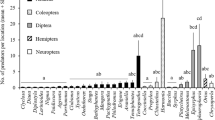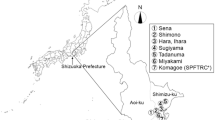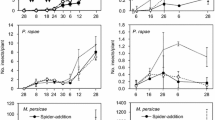Abstract
Citrus fruits are markedly affected by aphids on the island of Réunion (France). These pests are generally controlled with pesticides, which have adverse effects on human and environmental health. Furthermore, resident vegetation in orchards is often eliminated with herbicides due to suspected competition with citrus trees for resources. Yet this resident vegetation could serve as a habitat for natural enemies of crop pests, particularly ladybirds (Coleoptera: Coccinellidae), which are well-known aphid predators, thus reducing the need for pesticide treatments. Results of a 2-year study conducted in an experimental citrus orchard, on the impacts of four different weed management treatments on ladybird populations, viz: i) M: hedge-trimmer mowing; ii) T: disk harrow tilling; iii) HM: hammer mill crushing/mulching; iv) H: herbicide spraying are presented. Ladybirds were captured over a 5 week period each year using Malaise-derived flight interception traps. A total of 690 ladybird specimens, belonging to 12 species distributed across four subfamilies, were captured. These were mainly aphidophagous, with Scymnus constrictus Mulsant being largely dominant. There was a significant effect of distance to a field border with diversified vegetation on ladybird abundance and diversity. Ladybirds were also significantly more abundant on tall vegetation cover than on short cover. Although proportionately fewer ladybirds were trapped in the ‘H’ treatment than in the other three, there were no clearcut effects of weed management treatments on ladybird abundance. This study nevertheless confirmed the efficacy of interception traps for assessment of ladybird population abundance and diversity. It also demonstrated the potential of these natural enemies as bioindicators of habitat disturbance.




Similar content being viewed by others
References
Agreste (2015) Statistique agricole annuelle 2014 semi-définitive. Mémento 2015:34
Chazeau J, Etienne J, Fürsh H (1974) Les Coccinellidae de L’île de la Réunion (Insecta Coleoptera). Bulletin du Muséum National d’Histoire Naturelle 210/Zoologie 140, 265–297
DAAF La Réunion (2014) La production fruitière à La Réunion. Agreste La Réunion 92:1–12
Diepenbrock LM, Finke DL (2013) Refuge for native lady beetles (Coccinellidae) in perennial grassland habitats. Insect Conservation and Diversity 6:671–679
Dong ZK, Gao FJ, Zhang RZ (2012) Use of ryegrass strips to enhance biological control of aphids by ladybirds in wheat fields. Insect Science 19:529–534
Hanson BD, Roncoroni J, Hembree KJ, Molinar R, Elmore CL (2017) Weed control in orchards and vineyards, pp. 479–484. In Encyclopedia of applied plant sciences 2nd edn. (Edited by B. Thomas, B.G. Murray and D.J. Murphy). Academic Press (Elsevier Ltd), Waltham, U.S.A.
Hatt S, Mouchon P, Lopes T, Francis F (2017) Effects of wildflower strips and an adjacent forest on aphids and their natural enemies in a pea field. Insects 8:99
IUSS Working Group WRB (2015) World Reference Base for Soil Resources 2014, update 2015. International soil classification system for naming soils and creating legends for soil maps. World Soil Resources Reports 106. FAO, Rome
Koji S, Khan ZR, Midega CAO (2007) Field boundaries of Panicum maximum as a reservoir for predators and a sink for Chilo partellus. J Appl Entomol 131:186–196
Le Bellec F., Mailloux J., Dubois P., Rajaud A., Kreiter S., Bockstaller C., Tixier M.S. & Malezieux E. (2010) Phytoseiid mites (Acari) are bioindicators of agricultural practice impact on the agroecosystem functioning: the case of weed management in citrus orchards, pp. 157–158. In Proceedings of Agro 2010: the XIth ESA Congress, 29 August–3 September, 2010 Montpellier, France (Edited by J. Wery, I. Shili-Touzi and A. Perrin)
Long RF, Corbett A, Lamb C, Reberg-Horton C, Chandler J, Stimmann M (1998) Beneficial insects move from flowering plants to nearby crops. Calif Agric 52:23–26
Malaise R (1937) A new insect trap. Entomologisk Tidskrift 58:148–160
Marliac G, Simon S, Mazzia C, Penvern S, Lescourret F, Capowiez Y (2015) Increased grass cover height in the alleys of apple orchards does not promote Cydia pomonella biocontrol. Biocontrol 60:805–815
MEA (Millenium Ecosystem Assessment) (2005) Summary for decision makers, pp. 1–24. In Ecosystems and Human Well-being: Synthesis. Island Press, Washington D.C.
Nicolas V., Coutanceau J.-P., Poussereau J. and Gomy Y. 2015. Les Coccinelles de l'Île de La Réunion: Synthèse des données (Coleoptera, Coccinellidae), pp. 58–77. In Contribution à l’étude des Coléoptères de La Réunion: Supplément au Bulletin de liaison d’ACOREP-France « Le Coléoptériste » (Coordinated by Y. Gomy)
Phoofolo MW, Giles KL, Elliott NC (2010) Effects of relay-intercropping sorghum with winter wheat, alfalfa, and cotton on lady beetle (Coleoptera: Coccinellidae) abundance and species composition. Environ Entomol 39:763–774
Quilici S., Vincenot D. and Franck A. (2003) Les auxiliaires des cultures fruitières à l’île de la Réunion. CIRAD. Saint-Denis, 168 p
R Core Team (2015) R: A Language and Environment for Statistical Computing. 409–409
Rhino B, Verchere A, Thibaut C, Ratnadass A (2016) Field evaluation of sweet corn varieties for their potential as a trap crop for Helicoverpa zea under tropical conditions. International Journal of Pest Management 62:3–10
Rocha-Peña MA, Niblett CL, Lee RF, Ochoa-Corona FM, Lastra R, Garnsey SM, Yokomi RK (1995) CTV and its aphid vector Toxoptera citricida—threats to citrus production in the Caribbean and central and North America. Plant Dis 79:437–444
Sarospataki M, Marko V (1995) Flight activity of Coccinella septempunctata (Coleoptera: Coccinellidae) at different strata of a forest in relation to migration to hibernating sites. European Journal of Entomology 92:415–419
Sarthou JP (2009) Le piège cornet unidirectionnel, nouveau piège entomologique d’interception. L’Entomologiste 65:107–108
Shannon CE (1948) A mathematical theory of communication. AT&T Technical Journal 27, 379–423 and 623–656
Sheikh AH, Thomas M, Bhandari R, Meshram H (2016) Malaise trap and insect sampling: mini review. Bio Bulletin 2:35–40
Acknowledgements
The authors are grateful to Raphaëlle Mouttet (Anses, CBGP) for help with ladybird identification and Jean-Pierre Sarthou for his support in designing the interception traps used. We also thank all of the technical staff of the Bassin-Plat research station for implementation of the experiment and field management.
Funding
This study was financially supported by the French Biodiversity Agency (formerly ONEMA), in the framework of the tender ‘Biodiversité-Ecophyto’ (Agrum’Aide project, 2014–2018).
Author information
Authors and Affiliations
Corresponding author
Ethics declarations
Conflict of interest
The authors declare that they have no conflict of interest.
Disclaimer relating to prior publication
The authors declare that an earlier version of the presented work constituted a chapter of the PhD thesis of the first author, which although accessible from ‘https://tel.archives-ouvertes.fr/tel-01896389/file/DDOC_T_2017_0394_ROTHE.pdf‘, cannot be considered as a prior publication.
Additional information
Publisher’s note
Springer Nature remains neutral with regard to jurisdictional claims in published maps and institutional affiliations.
Rights and permissions
About this article
Cite this article
Rothé, M., Pelletier, N., Touneji-Catouaria, AM. et al. Impacts of weed management on ladybird (Coleoptera: Coccinellidae) abundance and diversity on resident vegetation in a citrus orchard. Int J Trop Insect Sci 39, 325–331 (2019). https://doi.org/10.1007/s42690-019-00055-0
Received:
Accepted:
Published:
Issue Date:
DOI: https://doi.org/10.1007/s42690-019-00055-0




